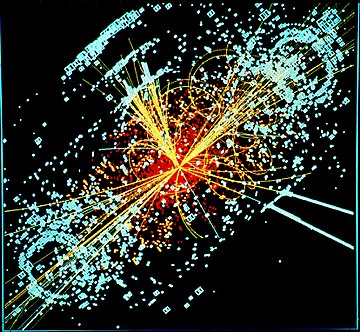
One possible signature of a Higgs boson from a simulated collision between two protons. It decays almost immediately into two jets of hadrons and two electrons, visible as lines.
Composition Elementary particle
Statistics Bosonic
Status A Higgs boson of mass ~ 125 GeV has been tentatively confirmed by CERN on
14 March 2013, although unclear as yet which model the particle best supports or whether multiple Higgs bosons exist.
Symbol H0
Theorised R. Brout, F. Englert, P. Higgs, G. S. Guralnik, C. R. Hagen, and T. W. B. Kibble (1964)
Discovered Previously unknown boson confirmed to exist on
4 July 2012, by the ATLAS and CMS teams at the Large Hadron Collider; tentatively confirmed as a Higgs boson of some kind on
14 March 2013 (see above).
Mass 125.3 ± 0.4 (stat) ± 0.5 (sys) GeV/c2, 126.0 ± 0.4 (stat) ± 0.4 (sys) GeV/c2
Mean lifetime 1.56×10−22 s (predicted in the Standard Model)
Decays into (observed) W and Z bosons, two photons. (Others still being studied)
Electric charge 0
Color charge 0
Spin 0 (tentatively confirmed at 125 GeV)
Parity +1 (tentatively confirmed at 125 GeV)
The Higgs boson or Higgs particle is an elementary particle initially theorized in 1964, and tentatively confirmed to exist on 14 March 2013. The discovery has been called "monumental" because it appears to confirm the existence of the Higgs field, which is pivotal to the Standard Model and other theories within particle physics. In this discipline, it explains why some fundamental particles have mass when the symmetries controlling their interactions should require them to be mass-less, and—linked to this—why the weak force has a much shorter range than the electromagnetic force. Its existence and knowledge of its exact properties are expected to impact scientific knowledge across a range of fields and should allow physicists to finally validate the last untested area of the Standard Model's approach to fundamental particles and forces, guide other theories and discoveries in particle physics, and—as with other fundamental discoveries of the past—potentially over time lead to developments in "new" physics, and new technologies.
This unanswered question in fundamental physics is of such importance that it led to a search of over 40 years for the Higgs boson and finally the construction of one of the most expensive and complex experimental facilities to date, the Large Hadron Collider, able to create and study Higgs bosons and related questions. On 4 July 2012, a previously unknown particle with a mass between 125 and 127 GeV/c2 was announced as being detected, which physicists suspected at the time to be the Higgs boson. By March 2013, the particle had been proven to behave, interact and decay in many of the expected ways predicted by the Standard Model, and was also tentatively confirmed to have + parity and zero spin, two fundamental criteria of a Higgs boson, making it also the first known scalar particle to be discovered in nature, although a number of other properties were not fully proven and some partial results do not yet precisely match those expected; in some cases data is also still awaited or being analyzed. As of March 2013 it is still uncertain whether its properties (when eventually known) will exactly match the predictions of the Standard Model, or whether additional Higgs bosons exist as predicted by some theories.